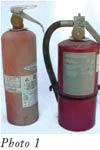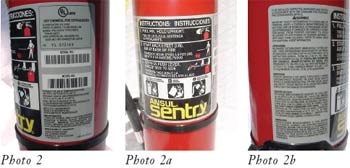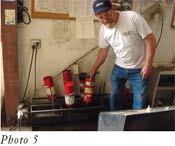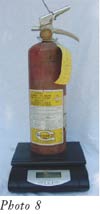The ABCs of Inspecting Dry Chemical Fire Extinguishers
An improperly maintained or under-weight extinguisher can seriously endanger life and property.
 When performing an inspection at a
business, you should inspect its fire
extinguishers. Looking at the psi
gauge to see whether the arrow is in the
green and inspecting the tag to determine
whether it is current or the extinguisher
needs to be inspected will tell you some
things about it, but there is a bit more you
should know.
When performing an inspection at a
business, you should inspect its fire
extinguishers. Looking at the psi
gauge to see whether the arrow is in the
green and inspecting the tag to determine
whether it is current or the extinguisher
needs to be inspected will tell you some
things about it, but there is a bit more you
should know.
The basic operation
of the stored
pressure extinguisher
is this: It contains in a
low pressure cylinder
the expellant gas,
usually nitrogen, and
the ABC or BC
chemical. When the
pin is removed from
the top handle and
the handle pressed
downward against
the bottom carrying handle, the valve stem
moves downward in the valve head and the
agent is released under pressure through a
siphon tube, up past the compression spring
and past the valve stem and valve head, out
through the hose and nozzle or nozzle.
Getting Started
The inspection should start
with a visual inspection.
Look for signs of damage,
welding, or any type of modification
made to the extinguisher;
that the valve head
assembly is not damaged;
handles are not missing (as
shown in Photo 1) or damaged;
the pull pin is located in the handle
with the tamper
seal holding the
pin in place; it has
no wire, wire tie,
or tape holding the
pin in place; and
the pressure gauge
arrow is in the
proper operating
range (usually in
the “green” area of the gauge). You should
able to read the pressure gauge, and it
should not be faded (Photo 1). You should
check the nozzle/nozzle and hose for
damage and weather cracks, that the orifice
is free from obstruction, and the
instruction-name plate is legible (Photo 1)
and attached to the fire extinguisher
cylinder; which will tell you about other
important factors of the fire extinguisher
that will be discussed here.
Reading the information on the labels
will tell you all about the fire extinguisher
and how to operate it. The letters and
pictures indicating the classes of fires it is
capable of extinguishing should appear
only on the front of the extinguisher;
nothing else should be placed on the
front to distract from the information.
The rating number that indicates the
extinguishing capability, information on
how much dry chemical should be in the
fire extinguisher, and the suitable temperatures
in which the agent will operate are
on the label, as
shown in the
Photos 2, 2a, and
2b below.
 The manufacture
date will tell
you two important
items about the fire
extinguisher you are
inspecting.The date
is found in one of
three places: on the
label, stamped on
the bottom outside
edge of the cylinder,
or stamped to the
underside of the extinguisher. Some companies
place a sticker showing the date of
manufacture.
The manufacture
date will tell
you two important
items about the fire
extinguisher you are
inspecting.The date
is found in one of
three places: on the
label, stamped on
the bottom outside
edge of the cylinder,
or stamped to the
underside of the extinguisher. Some companies
place a sticker showing the date of
manufacture.
This date is important because every
five years (for extinguishers carried in vehicles)
or 12 years (for those not
carried in vehicles, i.e., at businesses)
from the date of manufacture
or from the last “hydro”
sticker test date, the fire extinguisher
cylinder is to be hydrostatically
tested (“hydro
tested”), as shown in Photo 4.
Hydrostatic testing and the
yearly fire hose testing are
basically the same; the fire extinguisher cylinder is pressurized under
water pressure at test pressure. Photo 4
shows a modified out of jacket test performed.
If the cylinder passed the hydro
test, the inside cylinder is dried by hot air
on a drying rack before it is reassembled
and a hydro sticker is placed on the fire
extinguisher cylinder (Photo 5).
There are two types of hydrostatic test
stickers (Photo 6) that you may see: 1) non-
DOT cylinder, three times the gauge pressure
or to the manufacturer’s recommendation
on the label, the pressure, year, and
month the test was performed, 2) DOT
cylinder, which displays a “RIN” retested
identification number sticker, the cylinder
tested to twice the gauge pressure or to the
manufacturer’s recommendation, month
and year the test was performed. All test
information will be on the label.
 The California State Fire Marshal in
2003 implemented the “six year tear
down policy.” Any fire extinguisher
before 2003 would have the internal
maintenance conducted, powder emptied,
all parts cleaned, and the extinguisher
properly reassembled. After
completion of the work, a verification of
service collar (VSC) would be affixed
when placing the valve head assembly
into the cylinder to show that service was
performed and the date, month, and by
whom. (Photo 7)
The California State Fire Marshal in
2003 implemented the “six year tear
down policy.” Any fire extinguisher
before 2003 would have the internal
maintenance conducted, powder emptied,
all parts cleaned, and the extinguisher
properly reassembled. After
completion of the work, a verification of
service collar (VSC) would be affixed
when placing the valve head assembly
into the cylinder to show that service was
performed and the date, month, and by
whom. (Photo 7)
The next tear
down would be in
six years. Any fire
extinguisher 2003
or newer would
not have this VSC
unless service was
performed before
its “six year tear
down.”
The Importance of
the Gross Weight Check
The last check of the fire extinguisher,
and one that is mostly overlooked and
very important, is the gross weight
check. Looking on the label, you will find
the maintenance/recharge instructions; it
will tell you how many pounds of dry
chemical to put into the fire extinguisher
and the psi at which to pressurize the
cylinder. Compare label psi to what is on
the gauge, because this will tell you if it
has the proper gauge for that pressure. If
it does have a wrong gauge, this will
affect the discharge and rating of the fire
extinguisher.
 Check the gross weight with pin and tamper seal in place and the valve head,
including hose and nozzle or nozzle.
Proper hose and nozzle or nozzle as outlined
on the label must be correct, for this,
too, will affect the rating of the fire extinguisher
if it is wrong. Fire extinguishers
will have in writing the weight (gross) of
the total fire extinguisher or the parameters
to follow. For example, a 5 pound ABC
extinguisher will say on the label, “Fill with
5 pounds of ABC chemical . . . gross weight
of 8 lbs. 5oz. ± 8 oz.”
Check the gross weight with pin and tamper seal in place and the valve head,
including hose and nozzle or nozzle.
Proper hose and nozzle or nozzle as outlined
on the label must be correct, for this,
too, will affect the rating of the fire extinguisher
if it is wrong. Fire extinguishers
will have in writing the weight (gross) of
the total fire extinguisher or the parameters
to follow. For example, a 5 pound ABC
extinguisher will say on the label, “Fill with
5 pounds of ABC chemical . . . gross weight
of 8 lbs. 5oz. ± 8 oz.”
If you weigh this fire extinguisher,
it should not be
below 7 pounds, 14
ounces. A fire extinguisher
below the
minimal weight can
only happen when
the person who was
refilling the extinguisher
did not
bother letting the
chemical settle in
the cylinder and
then topping it off
with added chemical,
did not have a
scale, or did not use
a scale while doing
the maintenance.
One cannot know
what the actual
weight of the extinguisher
is without a
scale; just by hefting
the extinguisher,
your brain cannot
tell you whether it
is at the proper
weight—only whether it is heavy or light.
If it is below the minimum amount
allowed as stated on the label, this will once
again affect the rating of the fire extinguisher.
(Photo 8)
 Remember, all fire extinguisher labels
will instruct you: 1) to fill with proper
amount of chemical in pounds, and 2) what
the total gross weight should be of that particular
fire extinguisher.
If you do come across a fire extinguisher
with a deficiency during your inspection,
remove it from service and replace it with
another extinguisher in its place until the
deficiency is corrected.
The fire extinguisher is a very effective
tool to extinguish a fire before it gets out
of hand and endangers life or property,
but an extinguisher not properly maintained
or under weight can cause serious
danger to life and property. On your next
fire inspection, check out those other
items to make sure the people that are
counting on us know we do care for their
safety and are getting the proper service
they are paying for from a fire extinguisher
company.
Remember, all fire extinguisher labels
will instruct you: 1) to fill with proper
amount of chemical in pounds, and 2) what
the total gross weight should be of that particular
fire extinguisher.
If you do come across a fire extinguisher
with a deficiency during your inspection,
remove it from service and replace it with
another extinguisher in its place until the
deficiency is corrected.
The fire extinguisher is a very effective
tool to extinguish a fire before it gets out
of hand and endangers life or property,
but an extinguisher not properly maintained
or under weight can cause serious
danger to life and property. On your next
fire inspection, check out those other
items to make sure the people that are
counting on us know we do care for their
safety and are getting the proper service
they are paying for from a fire extinguisher
company.
This article originally appeared in the April 2008 issue of Occupational Health & Safety.